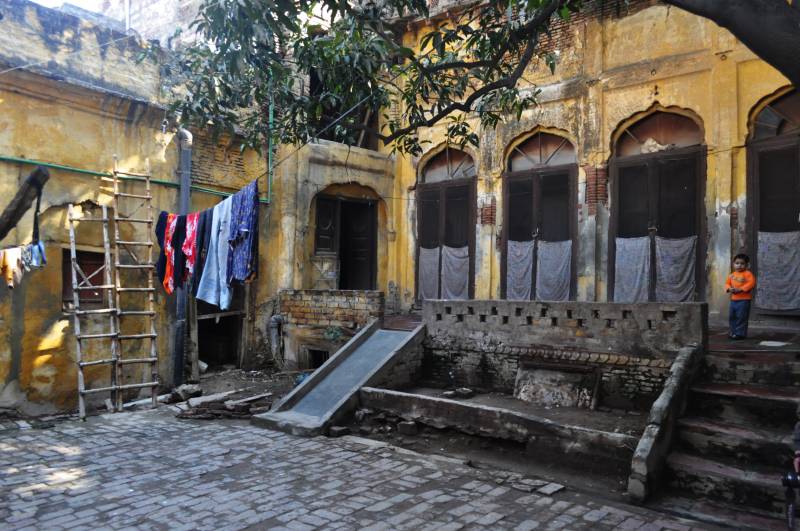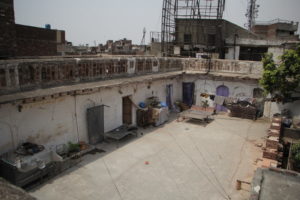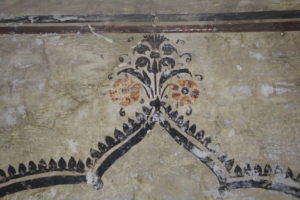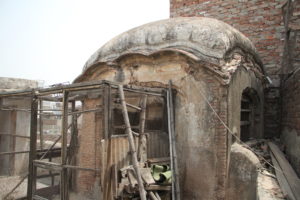
Tania Qureshi writes about the Sikh-era Haveli of Raja Dina Nath which remains a symbol of the grandiose Sindh architecture till date.
Walled City of Lahore is a masterpiece of architecture and construction and havelis make this city special and unique. Nowhere else in the world will you find such a setting where families live inside 400, 600 and 700 years old houses known as havelis.
Today let me take to you to a mesmerizing haveli inside Delhi Gate of the Walled City of Lahore. You take your way on the straight passage inside Delhi Gate and just before Chitta gate, which is the entrance to Chowk Wazir Khan, on your left will be the Phoolan Wali gali and inside it is this amazing piece called ‘Haveli of Dina Nath’.
The Haveli is named after a Hindu ruler, Dina Nath, who was a courtier during Ranjit Singh’s rule in Punjab. Raja Dina Nath, also known as Diwan Dina Nath, belonged to a Kashmiri Pandit family living in Delhi. Dina Nath was well known for his capabilities and therefore somewhere in 1815 Maharaja Ranjit Singh invited Dina Nath to Lahore and offered him the post of mutsaddi, meaning a writer, in the department of military accounts.

Dina Nath, being clever and skilled, managed to get a few other important positions. In 1826, after the demise of Diwan Ganga Ram, one of Ranjit Singh’s courtiers, Dina Nath succeeded him as the head of the military accounts department and keeper of the privy seal. Then in 1834, Dina Nath became the head of the civil and finance office.
Maharaja Ranjit Singh awarded the honorary title of Diwan to Dina Nath in 1838, which means the custodian of finances. According to historic accounts it is said that Raja Dina Nath was also one of the signatories to the treaty which was made between the Sikhs and the British after the First Anglo-Sikh War, which was fought between the Sikh empire and the East India Company between 1845 and 1846. Raja Dina Nath died in 1857 near Kot Khawaja Saeed, at Lahore, Pakistan. So after reading a little about the Raja you can imagine the glamour and majesty of his havelii
In the same haveli, a family is residing since partition.
Haveli of Raja Dina Nath is a comparatively huge Haveli located on Royal Trail inside Delhi Gate. Opposite to it you will see the Haveli of Bej Nath and also Haveli of Mian Sultan. Haveli Dina Nath reflects a typical Sikh Architecture. The total area of the Haveli is 47 Marla with nineteen rooms and two basements including verandas and an open space backyard.
The most dramatic and groovy feature of the haveli is its entrance. You will enter through a huge gate into a narrow passage having a dark stair case leading up into the haveli. You will have to carry some light or turn on your mobile flash light as it is pitch dark in the day too.
As you reach the door of the haveli, you will be awe stunned with the beautiful courtyard having rooms all around it and ages-old balconies on the second storey. You will see a typical Sikh architecture style in this haveli and till now the built and rooms tell about its grandeur. The yellow painted structure with a huge platform and basins of fountain was typical Sikh architecture with arches, balconies carvings, fresco work, worship places and the secret staircase to mezzanine floors.
Sikh architecture, developed almost 300 years ago, is a blend of sophistication, ascetic beauty, and elegant lines, which is reflected strongly in this Haveli.
Inside one of the main halls you will also see the Takht (platform) of Raja Dina Nath where he used to sit to hold his court and gathering. What a mesmerizing site it would have been in those days.

Now come to the mesmerizing feature of this haveli which is its basements. The residents called them as Sard Khana (Cold Room). Unfortunately the family has constructed rooms in one side of the basement but till a few years ago I had seen the unbelievable Sikh era basement.

The ceilings of this haveli are also an attractive feature and similar ceilings are seen in the Sikh era structures of Lahore fort. The cutwork of mirror and wood in the ceilings is taken as an expensive embellishment, and obviously this haveli had to have such embellishments.
If you go in to different rooms of the haveli you will see clear traces of fresco work on the walls but most of the fresco is hidden as the family regularly does the white wash on the walls.
There is a mezzanine floor too where it is said that the Raja had kept his records. The owner told me that her father in law did find some antique safes and cupboards but they never bothered about them and discarded them.
It is easy for the tourists to go in this haveli as the owner is a kind lady who has been living there for the last seventy years. If by any chance you are in the walled city Lahore, do visit this masterpiece or book a tourist guide from the Walled City of Lahore Authority and he can take you there.
Walled City of Lahore is a masterpiece of architecture and construction and havelis make this city special and unique. Nowhere else in the world will you find such a setting where families live inside 400, 600 and 700 years old houses known as havelis.
Today let me take to you to a mesmerizing haveli inside Delhi Gate of the Walled City of Lahore. You take your way on the straight passage inside Delhi Gate and just before Chitta gate, which is the entrance to Chowk Wazir Khan, on your left will be the Phoolan Wali gali and inside it is this amazing piece called ‘Haveli of Dina Nath’.
The Haveli is named after a Hindu ruler, Dina Nath, who was a courtier during Ranjit Singh’s rule in Punjab. Raja Dina Nath, also known as Diwan Dina Nath, belonged to a Kashmiri Pandit family living in Delhi. Dina Nath was well known for his capabilities and therefore somewhere in 1815 Maharaja Ranjit Singh invited Dina Nath to Lahore and offered him the post of mutsaddi, meaning a writer, in the department of military accounts.

Dina Nath, being clever and skilled, managed to get a few other important positions. In 1826, after the demise of Diwan Ganga Ram, one of Ranjit Singh’s courtiers, Dina Nath succeeded him as the head of the military accounts department and keeper of the privy seal. Then in 1834, Dina Nath became the head of the civil and finance office.
Maharaja Ranjit Singh awarded the honorary title of Diwan to Dina Nath in 1838, which means the custodian of finances. According to historic accounts it is said that Raja Dina Nath was also one of the signatories to the treaty which was made between the Sikhs and the British after the First Anglo-Sikh War, which was fought between the Sikh empire and the East India Company between 1845 and 1846. Raja Dina Nath died in 1857 near Kot Khawaja Saeed, at Lahore, Pakistan. So after reading a little about the Raja you can imagine the glamour and majesty of his havelii
In the same haveli, a family is residing since partition.
Haveli of Raja Dina Nath is a comparatively huge Haveli located on Royal Trail inside Delhi Gate. Opposite to it you will see the Haveli of Bej Nath and also Haveli of Mian Sultan. Haveli Dina Nath reflects a typical Sikh Architecture. The total area of the Haveli is 47 Marla with nineteen rooms and two basements including verandas and an open space backyard.
The most dramatic and groovy feature of the haveli is its entrance. You will enter through a huge gate into a narrow passage having a dark stair case leading up into the haveli. You will have to carry some light or turn on your mobile flash light as it is pitch dark in the day too.
As you reach the door of the haveli, you will be awe stunned with the beautiful courtyard having rooms all around it and ages-old balconies on the second storey. You will see a typical Sikh architecture style in this haveli and till now the built and rooms tell about its grandeur. The yellow painted structure with a huge platform and basins of fountain was typical Sikh architecture with arches, balconies carvings, fresco work, worship places and the secret staircase to mezzanine floors.
Sikh architecture, developed almost 300 years ago, is a blend of sophistication, ascetic beauty, and elegant lines, which is reflected strongly in this Haveli.
Inside one of the main halls you will also see the Takht (platform) of Raja Dina Nath where he used to sit to hold his court and gathering. What a mesmerizing site it would have been in those days.

Now come to the mesmerizing feature of this haveli which is its basements. The residents called them as Sard Khana (Cold Room). Unfortunately the family has constructed rooms in one side of the basement but till a few years ago I had seen the unbelievable Sikh era basement.

The ceilings of this haveli are also an attractive feature and similar ceilings are seen in the Sikh era structures of Lahore fort. The cutwork of mirror and wood in the ceilings is taken as an expensive embellishment, and obviously this haveli had to have such embellishments.
If you go in to different rooms of the haveli you will see clear traces of fresco work on the walls but most of the fresco is hidden as the family regularly does the white wash on the walls.
There is a mezzanine floor too where it is said that the Raja had kept his records. The owner told me that her father in law did find some antique safes and cupboards but they never bothered about them and discarded them.
It is easy for the tourists to go in this haveli as the owner is a kind lady who has been living there for the last seventy years. If by any chance you are in the walled city Lahore, do visit this masterpiece or book a tourist guide from the Walled City of Lahore Authority and he can take you there.
